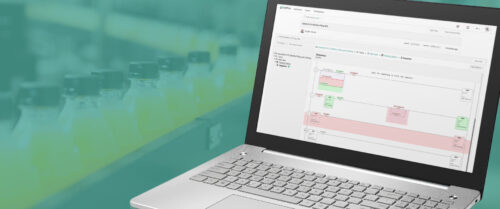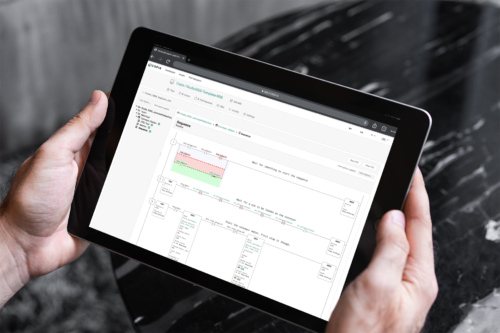Strategic maintenance, plant floor integration drive improvements
With maintenance-related activities accounting for a substantial portion of the total operating costs for manufacturing plants, manufacturers are placing increased emphasis on effectively managing production equipment and achieving the optimum level of asset utilization. While maintenance departments are relying on increasingly more powerful data collection and process tools, manufacturers can ...
With maintenance-related activities accounting for a substantial portion of the total operating costs for manufacturing plants, manufacturers are placing increased emphasis on effectively managing production equipment and achieving the optimum level of asset utilization. While maintenance departments are relying on increasingly more powerful data collection and process tools, manufacturers can achieve spectacular gains in maintenance efficiency and dollar savings by implementing a single control and information architecture that supports the entire enterprise.
The main goal of an integrated manufacturing environment is to eliminate isolated cells of activity by merging the entire manufacturing process into a single, coordinated system. The increased demand for plant-wide integration is being driven by a convergence of new business drivers. Standing in the thick of these demands are today’s plant managers, driven by the desire for ‘information-on-demand,’ and the importance of quickly capturing data and using it to influence the bottom line.
While a large amount of data comes from the manufacturing environment, that information has been limited because the custom integration used until now has been expensive, cumbersome and inflexible. Moreover, connectivity and compatibility challenges have made it difficult to upgrade, maintain and expand these systems.
The challenge for manufacturers is two-fold: the first part is how to bring this data into the control system without additional cost and complexity; the second is implementing a control system with sufficient flexibility to effectively and cost-efficiently integrate this data with the rest of the enterprise. This is where an integrated control and information architecture delivers its true value.
Benefits of an integrated architecture
At the heart of this integrated infrastructure is a control system that ties all control functionality into a single, multitasking controller. For example, because of the range of applications found within a plant, many companies use different automation control systems for each production discipline, such as discrete, motion and process.
While these individual control solutions were specifically designed for their intended application, integrating the various controllers for plant-wide automation can be time-consuming and costly. More importantly, however, decisions are made based on the limitations and boundaries of these disparate systems, diminishing the ability of plant managers to make timely, fully informed decisions.
With an integrated control platform, users are able to address a full range of control applications while providing seamless information integration with the rest of the site. With data transferred directly into the controller, users are able to integrate measurement instruments and automation controls, whether for discrete, process or hybrid applications — and do it in a single, unified environment with the ability to pass information between the different disciplines. By using a single programming and configuration software package for all controllers, users also gain access to a variety of configuration methods while at the same time reducing equipment, maintenance and development costs.
New networking technologies also are offering more power and transparency and are helping to break down the barriers to plant-wide integration. For example, open networking standards such as Ethernet/IP, ControlNet and DeviceNet allow for seamless information flow between the plant floor and the enterprise, and they enable the use of smarter end devices that generate more than simple on/off or open/closed data back to the automaton system.
With plant-wide connectivity, managers can use online diagnostic software to review the status of wired machinery simply by logging onto their network to view real-time data or obtain a complete analysis. Though most managers still get written reports, they now have the ability to send data over the Internet, as well as through electronic wireless connections like digital cell phones and pagers.
Boosting efficiency
The other driving factor behind plant-wide integration is the need to improve the efficiency of the maintenance department. To enable more efficient use of staff time, engineers can configure devices to report data as often and in whichever format is needed. For example, a drive controlling a rapidly fluctuating process might report status every 50 milliseconds, while a motor on a slower-changing process may only be required to report status every 60 seconds. For less critical processes, devices can be configured to communicate only when there is a change of state. Information reported by devices in the system could be recorded for later analysis or used to generate alarm messages as important events occur in the process.
With access to more detailed information over longer periods of time, maintenance managers are able to better predict potential problems and prevent catastrophic failures. Moreover, the improved quality and availability of data helps improve troubleshooting speed and accuracy. Rather than relying on obscure fault codes, maintenance personnel receive simple descriptions to pinpoint specific problems.
The ability of plants to integrate maintenance functions with the rest of the enterprise is a key component of a proactive strategy and is critical for long-term success. For example, planning long-term shutdowns for capital repairs needs long-term visibility into sales and operations planning. Likewise, the factory supply chain needs to consider and integrate the maintenance function in order to be responsive and proactive. This requires rethinking the way maintenance functions are executed in an organization, as well as providing support through robust, integrated systems that unite the data requirements across plant-wide systems and processes.
Proactive maintenance, made possible through plant-wide integration, impacts profitability on both sides of the asset equation: it helps increase revenues by increasing equipment performance; and it boosts return on assets by reducing the need for expensive capital upgrades to increase output.
The benefits of plant-wide integration are obvious. The first advantage is an increase in productivity. With a cohesive plant floor and the ability to gather information anywhere at any time, engineers can drive out the inefficiencies that habitually plague production. The second benefit is the ability to manufacture more products. If the entire plant is running efficiently, throughput will be amplified.
To reap the benefits of strategic maintenance, managers need access to all sources of manufacturing data. Plant-wide integration bridges the gap between the plant-floor and the rest of the enterprise by unleashing the relevant, real-time data embedded at the automation layer and exposing and delivering it to the people and systems that need it. Better knowledge and faster response to changing conditions will improve asset performance, reduce maintenance costs and speed time to market.
| Author Information |
| Mike Laszkiewicz is the vice president of Customer Support & Maintenance at Rockwell Automation. In his current role — and previously as general manager of Asset Management — he has been instrumental in developing the Rockwell Automation strategy for addressing the maintenance repair and operations (MRO) needs of manufacturers around the world. Since joining Rockwell Automation, Mike has held a number of different management positions with the company, in areas including product planning, customer services and repair services. After starting his work in the Manufacturing Operations division, he quickly moved to the Motion Control division, where he served as manager of product planning. He has also served as manager of customer service for the Drive Systems Business. Prior to joining the Asset Management business, he was director of Repair Services, Allen-Bradley Support Division. Laszkiewicz earned his bachelor’s degree in industrial operations management from the University of Wisconsin-Milwaukee. He is located in Milwaukee and can be reached at (414) 382-3317 or via e-mail to mlaszkiewicz@ra.rockwell.com . |
Do you have experience and expertise with the topics mentioned in this content? You should consider contributing to our CFE Media editorial team and getting the recognition you and your company deserve. Click here to start this process.





